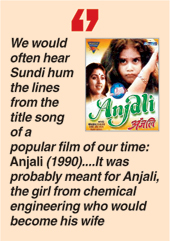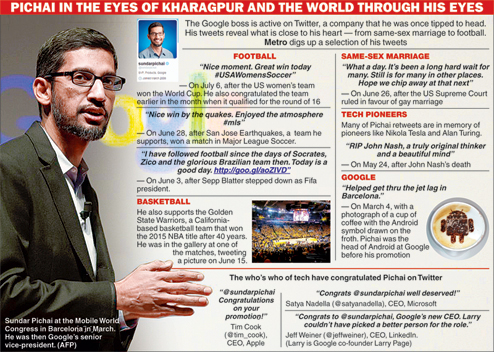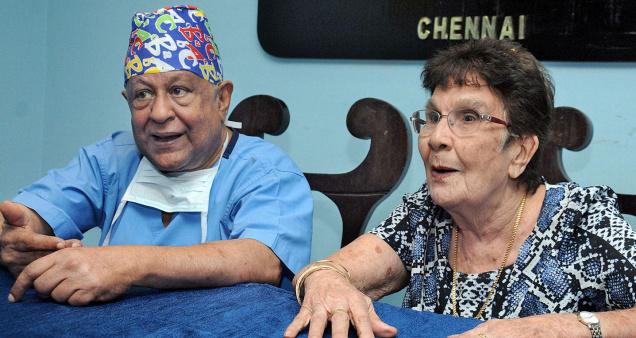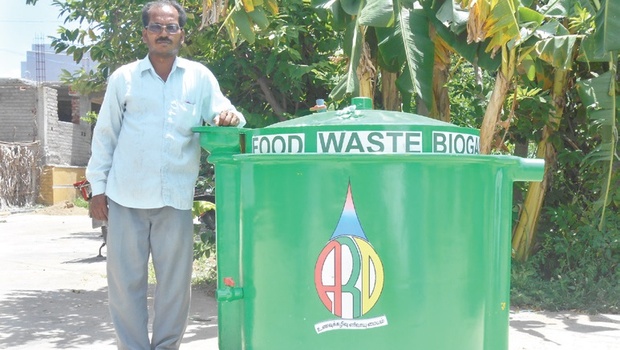Sundar Pichai, the toast of the technology world, learnt his engineering 110km from Calcutta two decades ago.
In the records of IIT Kharagpur, P. Sundararajan was the topper in metallurgy and material science in the Class of 1993. Outside the classroom, he was known as the ” chhupa rustam” who had wooed and won his life partner from the chemical engineering class without any of his hostel mates getting a whiff of it.
Metro spoke to some of the new Google CEO’s old friends and teachers to get an insight into the man that holds that brilliant mind.
Sourav Mukherji, dean of academic programmes at IIM Bangalore; studied civil engineering at IIT-K and shared the Nehru Hall with Pichai
The world may be hailing Sundar Pichai but to us in Kharagpur, he was Sundi. And he would sing ” Anjali Anjali, pyari Anjali ” all the time.

We would often hear Sundi hum the lines from the title song of a popular film of our time: Anjali (1990). He loved music and we all thought he sang the song because he liked it. It was much later, after we left Kharagpur, that we realised why he loved this particular song.
It was probably meant for Anjali, the girl from chemical engineering who would become his wife. We all knew Anjali and Sundi knew each other but we never came to know of their relationship in our four years on the campus. It was ‘surprise-surprise’ when we came to know that Sundi and Anjali were seeing each other.
He was a brilliant guy. In fact, a lot of people in the IITs are brilliant. But Sundi was absolutely brilliant. He was the topper in most exams when we were students at IIT. But nobody would call him bookish.
I feel that this (Pichai’s elevation at Google) is a moment of great joy and pride for us as Indians because two of the world’s most powerful IT companies now have Indians as their CEOs (Satya Nadella is the CEO of Microsoft). These gentlemen have truly been able to break the so-called glass ceiling. Twenty years ago, who would have thought that Indians would head powerful American companies, especially companies at the forefront of technology?

We checked our records but couldn’t trace anyone by that name. Later, the journalist gave us a clue: that he had been a recipient of a silver medal. That helped us track P. Sundararajan. Later, we contacted our alumni office in the US to check whether P. Sundararajan and Sundar Pichai were the same person and finally it was they who confirmed it.
I had taught him in all the four years he studied metallurgy and material science here. I found him exceptionally bright.
The IIT selected him for its Distinguished Alumni award this year and he was supposed to receive the honour at the annual convocation that was held recently. He couldn’t attend the event this time but he has promised to visit the institute when he comes to India next.
Phani Bhushan, co-founder of Anant Computing and Pichai’s batchmate and co-boarder at Nehru Hall, where he had stayed at “CTM” (that’s section C, top floor, middle wing)
Sundararajan was a shy person who was more comfortable in small groups, and now he is making speeches and heading a global conglomerate like Google. It is like he has had a personality U-turn.
We are super excited that our batchmate and hall mate has achieved such a feat, although it isn’t as surprising as the news that he married a fellow KGPian, Anjali!
We hall mates and batch mates tend to spend a lot of time together and we thought he was shy about talking to girls. But he turned out to be a chhupa rustam! We wonder how he managed to have a girlfriend without us knowing about it.
Partha Pratim Chakrabarti, director, IIT-KGP
We are all delighted that a student from Kharagpur has achieved this. Sundar Pichai was always a very quiet and studious person. I never taught him but have interacted with him several times. He recently did a video chat with an auditorium full of students who talked to him about everything from life to technology and leadership.
He hasn’t made any public statement as yet. That’s the kind of person he is. He likes to do his work. Sundar has proved that technological leadership can lead to global leadership and has given aspiration to a new generation of IITKgpians that you can achieve global leadership through technological leadership.
He is a quiet worker, a technical wizard, a great thinker and visionary who is also an extremely humble person, quite in sync with his alma mater IIT Kharagpur. He is an Indian who is a global leader and epitomises future generations of Indians.
source: http://www.telegraphindia.com / The Telegraph, Calcutta,India / Front Page> Calcutta> Story / Wednesday – August 12th, 2015





